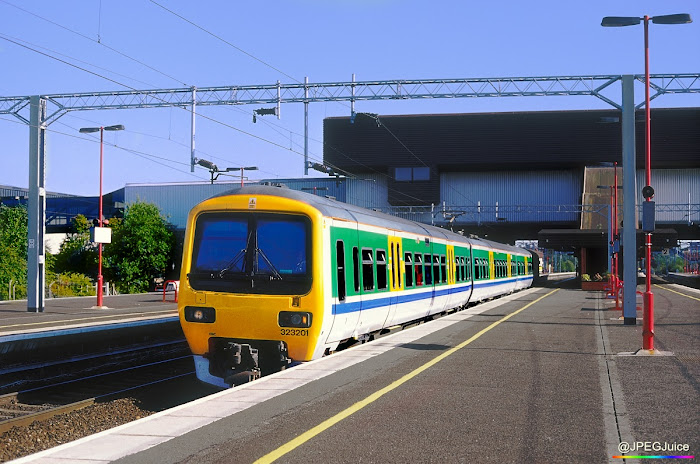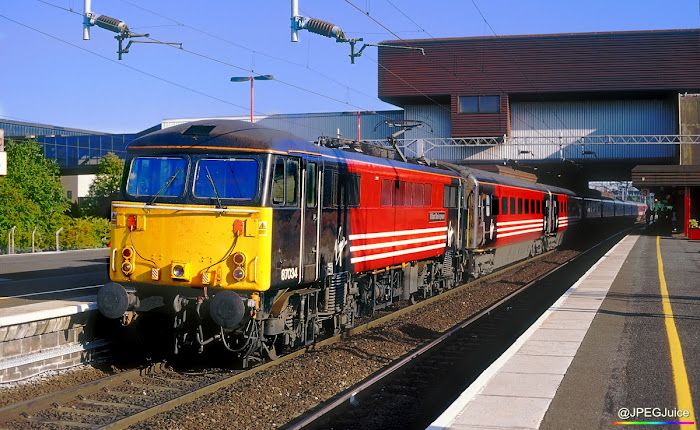A seat beside the NEC, for a pictorial snapshot of the period right before the start of Operation Princess.

We so often represent a moment in train spotting time with just a single snapshot. How much more informative would it be to see a whole afternoon’s worth of traffic in a single post? Well, that’s the concept behind An Afternoon at Birmingham International.
For this post I’ve raided a box of Kodak Elite Chrome Extra Color slides, for an insight into the typical rail traffic at the NEC’s rail exchange, on a very fine and warm Friday 13th September 2002. In the film era we were all driven to be selective to a degree. Every shot cost money, and the expense could start to mount up quickly if you were shooting every arrival/departure at a busy station such as this.
I made a decision not to photograph any Voyagers, as they were already dominant on CrossCountry and had a long life ahead of them. And I also omitted a shot of Wessex silver/yellow/maroon 158746 on the 16:46 Birmingham International – Cardiff. Probably due to a shortage of film. I now regret not capturing at least one double Voyager set on the day, and the 158. They would have completed the overview of traffic.
This photo session represents the final year of the pre-Pendolino era here, when Virgin’s West Coast services in the West Midlands were still solidly loco-hauled. The date in question also fell into the short interim between the end of CrossCountry loco-haulage (16/8/02), and the beginning of Operation Princess (30/9/02), when the routinely doubled-up Virgin Voyagers were split into single sets, decimating the volume of HST service. As such, there were no scheduled loco-hauled diesel passenger duties on this date, but the HSTs were still running as 7-car sets across a wide range of XC duties.

We begin with an unnamed 86259 heading the 16:37 departure for Birmingham New Street. These services from Euston departed half-hourly, with the xx:07 departures continuing to Wolverhampton. Two weeks later to the day, radio presenter & railway fan Les Ross made his final BRMB broadcast from the opposite station platform, and was gobsmacked when this loco turned up on his train home, bearing newly-affixed Les Ross nameplates.

The 11:17 Southampton West Docks - Crewe car train had been a booked 'Fred' turn since the previous year, and on this particular date was hauled by a silver-buffered 66601 The Hope Valley. Well-loaded with Ford vehicles, the long consist would turn off the main line at Stechford, taking the Birmingham-avoiding line round to Aston, and then heading out via Bescot to rejoin the main passenger route at Wolverhampton.

Class 43 power car 43098 The Railway Children. The HSTs were heading into their final couple of weeks as frontline CrossCountry stalwarts. They’d fronted the network for over two decades, beginning tentatively in latter 1981, and entering volume service the following May. On 30th September 2002, the classic 7-coach CrossCountry HST was scheduled to stand down. An allocation of sets would be taken out of the XC pool, and the remainder would be reformed into 5-coach Voyager supplements compatible with Operation Princess. However, well before the timetable switch, the reduced formations began to appear, cutting the remaining reign of the 7-car XC set even shorter.

I did head another post with a shot of this train, but this is a different view, which has never before been published. In 2002, 86228 Vulcan Heritage was repainted in the ‘Main Line’ version of InterCity livery (the same as standard IC but without the branding, basically). It was effectively a heritage repaint, but was not widely reported or recognised as such, since other Class 86s had made it into 2002 in their original BR InterCity colours, and it also appeared that some Virgin 86s had received non-heritage InterCity repaints whilst actually with Virgin. The train graced with the presence of 86228 here, is the 16:21 Wolverhampton – Euston.

Rewinding a little to 16:07, we find another common period sight from the Euston – Midlands routes: that of a Virgin red Class 90. 90006, bound in this shot for Wolverhampton, was one of 15 Nineties in use with Virgin West Coast at the time. The almost ad hoc allocation of Classes 86, 87 and 90 to these trains made for good variety and a little random factor.

This is the same train seen in the shot heading the post. The power car is 43196, and the destination is Bournemouth. Although the sea of red and dark grey looks very refreshing today, at the time it was unbendingly standardised across the Virgin 125 fleet. Unlike numerous Class 47s, the Virgin Class 43s did not see any heritage or special treatments in the latter throes of their frontline CrossCountry tenure. All BR and early Virgin variant liveries had been eliminated from the XC HSTs by spring 2001, and from that point forward the whole fleet carried this bog standard look across the board.

After all the talk of saving film for the most important stuff, you might wonder what I was doing photographing a 323 unit on a Coventry – Birmingham local. The answer is that 323201 was at this point in time a novelty. Up until late summer 2002, all Centro’s Class 323s had worn a standard livery with emerald green upper door sections, matching the window band. But 323201 had just been outshopped pioneering this new version of the livery with yellow upper doors. This accessibility measure was different from that originally implemented on the Centro Class 150s, which featured white marker strips each side of old-style emerald green doors. It would not in fact be until 2005 that the policy re the 150s was revised in line with the Class 323s’ yellow door aesthetic, so on the Centro network, this train was well ahead of its time.

Running 30 minutes late, this is the 16:15 Birmingham New Street – London Euston, propelled by Virgin red Class 87 No. 87034 William Shakespeare - or 'Bill the Quill', as some knew it. It was not clear at this time how long the 87s would remain in traffic with Virgin, but it certainly didn’t look likely that they’d survive until their eventual chucking-out time of June 2005. It was known that the Virgin 86s were close to the end of their days, and indeed the CrossCountry examples had already gone by September 2002. There were Pendolinos around – they just hadn’t yet started squadron service on the Euston – West Midlands routes. Once they did, the 86s would quickly disappear (2003) – followed, it was presumed, by the 87s. In practice, however, it would be the Virgin 90s that would follow the 86s, in 2004, with the Virgin 87s dropping off the books last.

Although one might imagine that by 2002, with Pendolinos creeping into view, there would be no need for Virgin to scavenge postal power from EWS, that evidently was not the case. 86210, on spot hire from the mighty freight operator, is seen propelling Virgin’s 15:21 Wolverhampton – Euston, as Silverlink’s slow train from Euston to Birmingham readies to depart in the opposite direction in the shape of 321415.

Almost time to go home, but not before we’ve had a look at 43153 The English Riviera on a long CrossCountry journey to Edinburgh, via Newcastle. 43103 Helston Furry Dance was pushing from the rear. 43153 had been one of the power cars painted in Virgin's original HST livery, with yellow cab roof and 'XC' branding. But by this time it had been kicking around in the standard version for approaching two years.
So, that’s what the rail traffic at Birmingham International station looked like on a typical afternoon in September 2002. Interest heavily depleted as compared with the previous September, when Voyagers had barely been touching the station and CrossCountry still offered a wealth of diesel loco haulage. But compared with today?… A different world.